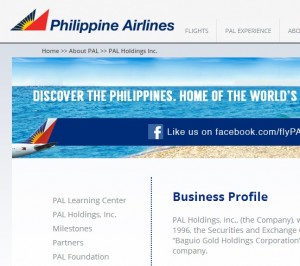The listed operator of Philippine Airlines made a turnaround in the second quarter of 2014, which typically sees a boost in travel due to the summer break, with the international business helping lift the flag carrier out of successive quarters of decline.
PAL Holdings Inc. said Friday in a stock exchange filing that net income in the three months ending June hit P1.46 billion versus a loss of P1.06 billion during the same period last year.
PAL Holdings booked a net income of P361.4 million in the first six months, although comparative figures were not immediately available.
As noted, higher revenues during the quarter were reported, suggesting that PAL’s management, now led by San Miguel Corp., was making progress in making the flag carrier profitable once again.
PAL is controlled by the family of taipan Lucio Tan, which is currently seeking to buy back SMC’s stake.
SMC president Ramon S. Ang said in a text message Friday that PAL would end 2014 profitable, after years of booking losses.
PAL mainly competes with budget carrier Cebu Pacific Air, which has rapidly expanded its business and market share by offering cheaper fares in line with its low-cost carrier model.
PAL nevertheless managed to grow revenues by 47.4 percent to P27.3 billion during the second quarter of 2014.
Of that figure, about 85 percent came from passenger revenues, which increased by half to P23.1 billion, its financial report showed.
“The increase was attributable mainly to the favorable passenger revenue performance during the quarter. This was brought about mainly by the introduction of new routes such as London, Abu Dhabi, Dammam, Riyadh, Canton, and Haneda, Japan,” PAL said in its filing.
Focusing on profitable international routes was a key part of PAL’s strategy, Ang said in a previous interview.
“The economy has been improving as well as this thrust in tourism so PAL has benefited from that as well,” Joseph Roxas, president of stock brokerage firm Eagle Equities Inc., said in an interview.
The airline is currently expanding via an ongoing $9.5-billion refleeting program with planes from Europe’s Airbus S.A.S. and last year, it took a hit from the write-down of old planes that were retired.
Ang said newer planes would ensure more efficient operations, both in terms of fuel consumption and maintenance costs.
PAL reported that total operating expenses rose 31 percent to P19.47 billion.
Fuel costs during the period expanded 26.6 percent to P7.76 billion as the carrier mounted more flights.
PAL had 85 planes at the end of June, including six Boeing 777-300ERs and, 10 Airbus A340-300s and 18 Airbus A330-300s, mainly for international flights. Miguel R. Camus
